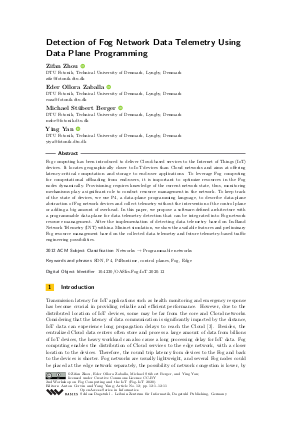Detection of Fog Network Data Telemetry Using Data Plane Programming
Authors
Zifan Zhou  ,
Eder Ollora Zaballa
,
Eder Ollora Zaballa  ,
Michael Stübert Berger
,
Michael Stübert Berger  ,
Ying Yan
,
Ying Yan 
-
Part of:
Volume:
2nd Workshop on Fog Computing and the IoT (Fog-IoT 2020)
Part of: Series: Open Access Series in Informatics (OASIcs)
Part of: Conference: Workshop on Fog Computing and the IoT (Fog-IoT) - License:
 Creative Commons Attribution 3.0 Unported license
Creative Commons Attribution 3.0 Unported license
- Publication Date: 2020-04-08
File

PDF
OASIcs.Fog-IoT.2020.12.pdf
- Filesize: 2.75 MB
- 11 pages
Document Identifiers
Subject Classification
ACM Subject Classification
- Networks → Programmable networks
Keywords
- SDN
- P4
- P4Runtime
- control planes
- Fog
- Edge
Metrics
- Access Statistics
-
Total Accesses (updated on a weekly basis)
0Document
0Metadata
Abstract
Fog computing has been introduced to deliver Cloud-based services to the Internet of Things (IoT) devices. It locates geographically closer to IoT devices than Cloud networks and aims at offering latency-critical computation and storage to end-user applications. To leverage Fog computing for computational offloading from end-users, it is important to optimize resources in the Fog nodes dynamically. Provisioning requires knowledge of the current network state, thus, monitoring mechanisms play a significant role to conduct resource management in the network. To keep track of the state of devices, we use P4, a data-plane programming language, to describe data-plane abstraction of Fog network devices and collect telemetry without the intervention of the control plane or adding a big amount of overhead. In this paper, we propose a software-defined architecture with a programmable data plane for data telemetry detection that can be integrated into Fog network resource management. After the implementation of detecting data telemetry based on In-Band Network Telemetry (INT) within a Mininet simulation, we show the available features and preliminary Fog resource management based on the collected data telemetry and future telemetry-based traffic engineering possibilities.
Cite As Get BibTex
Zifan Zhou, Eder Ollora Zaballa, Michael Stübert Berger, and Ying Yan. Detection of Fog Network Data Telemetry Using Data Plane Programming. In 2nd Workshop on Fog Computing and the IoT (Fog-IoT 2020). Open Access Series in Informatics (OASIcs), Volume 80, pp. 12:1-12:11, Schloss Dagstuhl – Leibniz-Zentrum für Informatik (2020)
https://doi.org/10.4230/OASIcs.Fog-IoT.2020.12
BibTex
@InProceedings{zhou_et_al:OASIcs.Fog-IoT.2020.12,
author = {Zhou, Zifan and Ollora Zaballa, Eder and Berger, Michael St\"{u}bert and Yan, Ying},
title = {{Detection of Fog Network Data Telemetry Using Data Plane Programming}},
booktitle = {2nd Workshop on Fog Computing and the IoT (Fog-IoT 2020)},
pages = {12:1--12:11},
series = {Open Access Series in Informatics (OASIcs)},
ISBN = {978-3-95977-144-3},
ISSN = {2190-6807},
year = {2020},
volume = {80},
editor = {Cervin, Anton and Yang, Yang},
publisher = {Schloss Dagstuhl -- Leibniz-Zentrum f{\"u}r Informatik},
address = {Dagstuhl, Germany},
URL = {https://drops.dagstuhl.de/entities/document/10.4230/OASIcs.Fog-IoT.2020.12},
URN = {urn:nbn:de:0030-drops-120062},
doi = {10.4230/OASIcs.Fog-IoT.2020.12},
annote = {Keywords: SDN, P4, P4Runtime, control planes, Fog, Edge}
}
Author Details
References
- Pat Bosshart, Dan Daly, Glen Gibb, Martin Izzard, Nick McKeown, Jennifer Rexford, Cole Schlesinger, Dan Talayco, Amin Vahdat, George Varghese, et al. P4: Programming protocol-independent packet processors. ACM SIGCOMM Computer Communication Review, 44(3):87-95, 2014. URL: https://doi.org/10.1145/2656877.2656890.
- P4 Language Consortium. Behavioral model (bmv2). URL: https://github.com/p4lang/behavioral-model [cited 2020-01-21]. URL: https://github.com/p4lang/behavioral-model.
- Amir Vahid Dastjerdi, Harshit Gupta, Rodrigo N Calheiros, Soumya K Ghosh, and Rajkumar Buyya. Fog computing: Principles, architectures, and applications. In Internet of things, pages 61-75. Elsevier, 2016. URL: https://doi.org/10.1016/B978-0-12-805395-9.00004-6.
- Krittin Intharawijitr, Katsuyoshi Iida, and Hiroyuki Koga. Analysis of fog model considering computing and communication latency in 5g cellular networks. In 2016 IEEE International Conference on Pervasive Computing and Communication Workshops (PerCom Workshops), pages 1-4. IEEE, 2016. URL: https://doi.org/10.1109/PERCOMW.2016.7457059.
- Vimalkumar Jeyakumar, Mohammad Alizadeh, Yilong Geng, Changhoon Kim, and David Mazières. Millions of little minions: Using packets for low latency network programming and visibility. ACM SIGCOMM Computer Communication Review, 44(4):3-14, 2014. URL: https://doi.org/10.1145/2740070.2626292.
- Rutvij H Jhaveri, Rui Tan, Arvind Easwaran, and Sagar V Ramani. Managing industrial communication delays with software-defined networking. In 2019 IEEE 25th International Conference on Embedded and Real-Time Computing Systems and Applications (RTCSA), pages 1-11. IEEE, 2019. URL: https://doi.org/10.1109/RTCSA.2019.8864557.
-
Changhoon Kim, Anirudh Sivaraman, Naga Katta, Antonin Bas, Advait Dixit, and Lawrence J Wobker. In-band network telemetry via programmable dataplanes. In ACM SIGCOMM, 2015.

- Bob Lantz, Brandon Heller, and Nick McKeown. A network in a laptop: rapid prototyping for software-defined networks. In Proceedings of the 9th ACM SIGCOMM Workshop on Hot Topics in Networks, pages 1-6, 2010. URL: https://doi.org/10.1145/1868447.1868466.
- Nick McKeown, Tom Anderson, Hari Balakrishnan, Guru Parulkar, Larry Peterson, Jennifer Rexford, Scott Shenker, and Jonathan Turner. Openflow: enabling innovation in campus networks. ACM SIGCOMM Computer Communication Review, 38(2):69-74, 2008. URL: https://doi.org/10.1145/1355734.1355746.
- Mithun Mukherjee, Suman Kumar, Mohammad Shojafar, Qi Zhang, and Constandinos X Mavromoustakis. Joint task offloading and resource allocation for delay-sensitive fog networks. In ICC 2019-2019 IEEE International Conference on Communications (ICC), pages 1-7. IEEE, 2019. URL: https://doi.org/10.1109/ICC.2019.8761239.
- Subhadeep Sarkar and Sudip Misra. Theoretical modelling of fog computing: a green computing paradigm to support iot applications. Iet Networks, 5(2):23-29, 2016. URL: https://doi.org/10.1049/iet-net.2015.0034.
-
William Stallings. SNMP, SNMPv2, SNMPv3, and RMON 1 and 2. Addison-Wesley Longman Publishing Co., Inc., 1998.

- Deze Zeng, Lin Gu, Song Guo, Zixue Cheng, and Shui Yu. Joint optimization of task scheduling and image placement in fog computing supported software-defined embedded system. IEEE Transactions on Computers, 65(12):3702-3712, 2016. URL: https://doi.org/10.1109/TC.2016.2536019.
